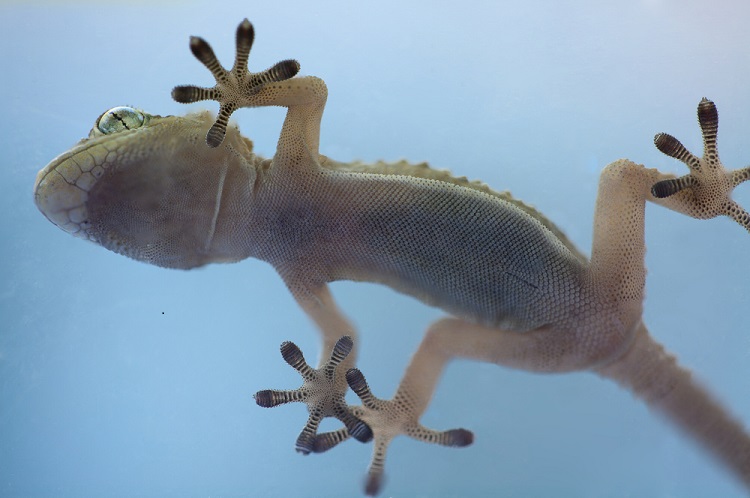Geckos' Sticky Secret? They Hang by Toe Hairs

Geckos are famous for their ability to scale vertical walls and even hang upside down, and now scientists understand more about how the expert climbers can pull off these gravity-defying feats: Geckos can quickly turn the stickiness of their feet on and off, a new study finds.
Gecko toes are well-studied and their sticky properties have inspired some incredible technology, such as stitch-free ways to seal wounds and sticky handheld paddles that may help soldiers scale walls someday. For the past decade, researchers have been developing synthetic adhesives with nanoscale fibers designed to mimic bristly gecko toes.
But new research on the subtleties of gecko adhesion shows that nature is still outpacing scientists in the lab. [Biomimicry: 7 Technologies Inspired by Nature]
Geckos can stick to surfaces because their bulbous toes are covered in hundreds of tiny microscopic hairs called setae. Each seta splits off into hundreds of even smaller bristles called spatulae. Scientists already knew that the tufts of tiny hairs get so close to the contours in walls and ceilings that the van der Waals force kicks in. This type of physical bond happens when electrons from the gecko hair molecules and electrons from the wall molecules interact with each other and create an electromagnetic attraction.
Now researchers have discovered how a balance of forces acting on the gecko and the angle of its toe hairs contribute to the creature's sticking success. The system makes it possible for geckos to stick and unstick their feet so quickly that they can scurry across surfaces at 20 body lengths per second.
"A gecko by definition is not sticky — he has to do something to make himself sticky," study lead author Alex Greaney, a professor of engineering at Oregon State University in Corvallis, told Live Science. "It's this incredible synergy of the flexibility, angle and extensibility of the hairs that makes it possible."
Greaney and a team of researchers created a mathematical model that shows how the setae angle and the forces that act on a gecko as it climbs interact to create a delicate but powerful sticking system.
Get the world’s most fascinating discoveries delivered straight to your inbox.
The setae sprouting off the bottom of a gecko's feet don't stand straight up at a 90-degree angle, but instead branch out at oblique angles. The mathematical model shows that if the hairs bend at an angle closer to horizontal, the surface area that the geckos can stick to increases, and the geckos can support more weight.
Setae are also ultraflexible. When a gecko jumps to another surface or quickly changes direction to escape a predator, its toe hairs must absorb huge amounts of energy and redirect it. The flexibility and stretchiness of the setae help redirect the energy and make it possible for geckos to walk across surfaces at any angle, unless the surface is covered in too much moisture, in which case their sticking powers are reduced and their feet start slipping. Setae that are too flexible or setae that are too long would get tangled up and cause geckos to slide and fall off surfaces, Greaney said.
The model also showed that geckos are able to balance out the force of gravity by applying their own force to a wall; they can press and slide their feet toward their body and drag their feet across surfaces without falling. Greaney said the next step is to explore the role that friction plays.
Details of the research were published today (Aug. 12) in the Journal of Applied Physics.
Follow Kelly Dickerson on Twitter. Follow us @livescience, Facebook & Google+. Original article on Live Science.



